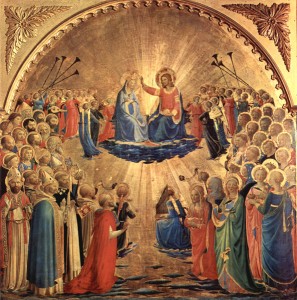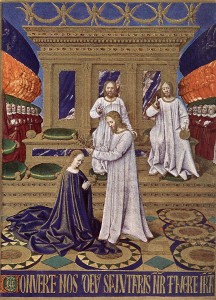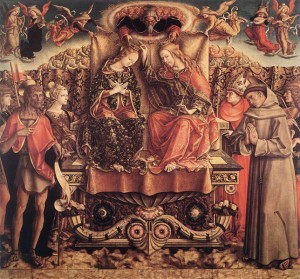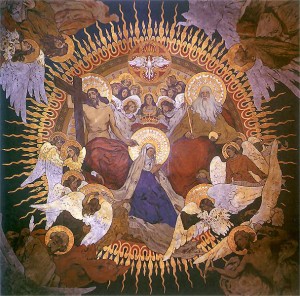Hail, Queen of heav’n, the ocean star,
Guide of the wand’rer here below;
Thrown on life’s surge, we claim thy care:
Save us from peril and from woe.Mother of Christ, O Star of the sea,
Pray for the wanderer, pray for me.
One of the most beautiful and misunderstood customs of Catholics — and perhaps one of the more relevant in today’s situation — is to refer to the Blessed Virgin Mary as “Queen” — of Heaven, of the Angels, and of much else besides. For Protestant Fundamentalists, these titles, so similar to those once given pagan goddesses, are proof of the Church’s heathen, non-Christian nature. For many Catholics not well formed in their religion, they can be a source of confusion. For quite a number of the powerful, they are a clear challenge. For the committed Catholic, they are and should be a rally-cry. The Queenship of Mary, like the Kingship of Christ, reflects a rulership that spans Heaven and Earth — regardless of whoever might recognize it or refuse to.
To begin with, it is important to realize that, due to the intimate nature of their relationship, Mary’s Queenship is as much bound up with her Son’s Kingship as her Immaculate Heart is tied to His Sacred one. All of her greatness, her ability to aid those who seek her intercession, her role in the saving mission of her Son, derives completely from His power and presence — she does not and cannot stand alone. Nevertheless, Mary’s continuing place in His life and work puts her above every other person, place or thing He has created.
Pope Pius XII was the first Pontiff to create a feast day for the entire Western Church in honor of the Queenship of Mary, which he unveiled in an encyclical, Ad Caeli Reginam, which he released on October 11, 1954 — just as his predecessor, Pius XI, announced the Feast of the Kingship of Christ in Quas Primas. But the topic had been on his mind for quite some time. In a radio broadcast to the Portuguese people on May 13, 1946, the Pontiff declared that:
He, the Son of God, reflects on His heavenly Mother the glory, the majesty and the dominion of His kingship, for, having been associated to the King of Martyrs in the unspeakable work of human Redemption as Mother and cooperator, she remains forever associated to Him, with a practically unlimited power, in the distribution of the graces which flow from the Redemption. Jesus is King throughout all eternity by nature and by right of conquest: through Him, with Him, and subordinate to Him, Mary is Queen by grace, by divine relationship, by right of conquest, and by singular choice [of the Father]. And her kingdom is as vast as that of her Son and God, since nothing is excluded from her dominion.
He began the afore-mentioned encyclical with the stirring words: “From the earliest ages of the Catholic church a Christian people, whether in time of triumph or more especially in time of crisis, has addressed prayers of petition and hymns of praise and veneration to the Queen of Heaven. And never has that hope wavered which they placed in the Mother of the Divine King, Jesus Christ; nor has that faith ever failed by which we are taught that Mary, the Virgin Mother of God, reigns with a mother’s solicitude over the entire world, just as she is crowned in heavenly blessedness with the glory of a Queen.”
Pius XII then went on to witness, as it were, to this Queenship in the very face of the horrors that he and the rest of the planet saw in the course of World War II and the Communist takeovers that followed in its wake: “Following upon the frightful calamities which before Our very eyes have reduced flourishing cities, towns, and villages to ruins, We see to Our sorrow that many great moral evils are being spread abroad in what may be described as a violent flood. Occasionally We behold justice giving way; and, on the one hand and the other, the victory of the powers of corruption. The threat of this fearful crisis fills Us with a great anguish, and so with confidence We have recourse to Mary Our Queen, making known to her those sentiments of filial reverence which are not Ours alone, but which belong to all those who glory in the name of Christian.” As Pius XI felt the need to proclaim the Kingship of Christ in the very teeth of the ruin wrought by the First World War, so too with his successor.
In the course of this encyclical, Pius XII made it clear that “In this matter We do not wish to propose a new truth to be believed by Christians, since the title and the arguments on which Mary’s queenly dignity is based have already been clearly set forth, and are to be found in ancient documents of the Church and in the books of the sacred liturgy.” He went on to trace the practice back to the Fathers of the Church. Citing Popes, Councils, Saints, and liturgies East and West, the rosary, and even artwork, the Pontiff showed clearly both the antiquity and the authority behind the idea of Mary’s Queenship over all.
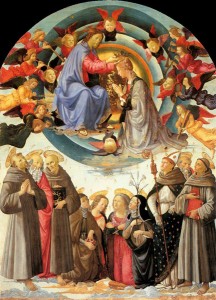
GHIRLANDAIO, Domenico, Coronation of the Virgin, 1486, Tempera on wood, Pinacoteca Comunale, Citta di Castello
This status, he explained, was based upon several distinct but inseparable foundations: her royal descent from the House of David, her Divine Motherhood, and her ongoing work in our personal salvation. Therefore, “Let all Christians, therefore, glory in being subjects of the Virgin Mother of God, who, while wielding royal power, is on fire with a mother’s love.” To mark this essential truth, he dedicated May 31 as the feast of the Queenship of Mary. In Spain and elsewhere, this had been the local feast of Mary, Queen of All Saints; in 1969, it was transferred to August 22, heretofore the feast of the Immaculate Heart of Mary (which in turn was moved to the day after the Sacred Heart of Jesus). In communities using the Extraordinary Form of the Roman Rite, the days continue to be celebrated on their traditional dates.
Pius also outlined precisely how Catholics should respond — not only to the new feast, but to the Queenship it celebrated itself:
Let all, therefore, try to approach with greater trust the throne of grace and mercy of our Queen and Mother, and beg for strength in adversity, light in darkness, consolation in sorrow; above all let them strive to free themselves from the slavery of sin and offer an unceasing homage, filled with filial loyalty, to their Queenly Mother. Let her churches be thronged by the faithful, her feast-days honored; may the beads of the Rosary be in the hands of all; may Christians gather, in small numbers and large, to sing her praises in churches, in homes, in hospitals, in prisons. May Mary’s name be held in highest reverence, a name sweeter than honey and more precious than jewels; may none utter blasphemous words, the sign of a defiled soul, against that name graced with such dignity and revered for its motherly goodness; let no one be so bold as to speak a syllable which lacks the respect due to her name.
Vatican II added to the Blessed Virgin’s titles a new one, Mother of the Church; moreover, it was on this point quite clear in Lumen Gentium: “This most Holy Synod deliberately teaches this Catholic doctrine and at the same time admonishes all the sons of the Church that the cult, especially the liturgical cult, of the Blessed Virgin, be generously fostered, and the practices and exercises of piety, recommended by the magisterium of the Church toward her in the course of centuries be made of great moment, and those decrees, which have been given in the early days regarding the cult of images of Christ, the Blessed Virgin and the saints, be religiously observed.”
Despite this, in the years following the Council, a misinterpretation of its intent led devotion to the Virgin to be downgraded wrongly in many areas, despite the best efforts in Paul VI, as in his 1966 encyclical, Christi Matris, where he wrote “Nothing seems more appropriate and valuable to Us than to have the prayers of the whole Christian family rise to the Mother of God, who is invoked as the Queen of Peace, begging her to pour forth abundant gifts of her maternal goodness in midst of so many great trials and hardships.” He returned to this theme in the 1974 apostolic exhortation, Marialis Cultus, wherein he made reference to her “Maternal Queenship.”
In his discourse of July 23, 1997, John Paul II, in speaking of Mary’s Queenship, declared that “With this further recognition of her sublime dignity, the Christian people want to place her above all creatures, exalting her role and importance in the life of every person and of the whole world;” he went on to summarize approvingly Pius XII’s encyclical. Benedict XVI, in his Angelus Message of November 26, 2006 tells us that “The Virgin Mary was associated in a very special way with Christ’s kingship. God asked her, a humble young woman of Nazareth, to become Mother of the Messiah and Mary responded to this request with her whole self, joining her unconditional ‘yes’ to that of her Son, Jesus, and making herself obedient with him even in his sacrifice. This is why God exalted her above every other creature and Christ crowned her Queen of Heaven and earth.”
All of this being so, how is the average Catholic to keep in mind this Queenship to which all of us are subject? The first step is by careful attention to all the standard prayers by which the Church reminds of Mary’s regal office. The easiest of these is the last of the Glorious Mysteries of the Holy Rosary — the Coronation of the Virgin as Queen of Heaven and Earth.
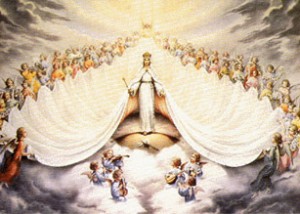 The four Marian antiphons or hymns of the Liturgy of the Hours each refer to Mary’s Queenship: the Salve Regina, Ave Regina Caelorum, Alma Redemptoris Mater, and Regina Caeli. The last section of the Litany of Loretto is taken up with invocations of the Virgin as Queen — of Angels, Patriarchs, Prophets, Apostles, Martyrs, Confessors, Virgins, Saints, conceived without original sin, assumed into heaven, of the most holy Rosary, and of peace. The first of these is especially worth thinking about, for Mary’s reign over the angels was signified by the honor and deference the Archangel St. Gabriel showed her when announcing her conception of Jesus.
The four Marian antiphons or hymns of the Liturgy of the Hours each refer to Mary’s Queenship: the Salve Regina, Ave Regina Caelorum, Alma Redemptoris Mater, and Regina Caeli. The last section of the Litany of Loretto is taken up with invocations of the Virgin as Queen — of Angels, Patriarchs, Prophets, Apostles, Martyrs, Confessors, Virgins, Saints, conceived without original sin, assumed into heaven, of the most holy Rosary, and of peace. The first of these is especially worth thinking about, for Mary’s reign over the angels was signified by the honor and deference the Archangel St. Gabriel showed her when announcing her conception of Jesus.
Beyond the realm of ordinary prayers, there are more external signs to ponder. Innumerable statues and images of the Virgin around the world have been “crowned” — with actual crowns — to remind the Faithful of Mary’s Queenship. Often they are revered because of the intercession prayer before them has brought in war, earthquake, famine, or other catastrophe. The Pilgrim Statue of Our Lady of Fatima, which makes its rounds throughout the world, is one of these. Those fortunate enough to venerate such a statue would do well to make Our Lady’s Queenship uppermost in thoughts: and to ponder what that Queenship demands of them. The same is true at May Crownings. Certain religious orders have particular feasts and practices that reflect upon the Queenship of Mary, and layfolk associated with these orders should take these to heart.
It is important to remember that the Queenship of Mary is not simply a passive object of contemplation, but also very much a real world reality. In addition to the Queenship of Mary, Popes have instituted certain feast days to commemorate interventions by the Virgin’s regal power at critical moments in the life of the Church. The Feast of Our Lady of the Rosary (originally “of Victory”) on October 7 was instituted by St. Pius V to thank the Virgin for her intercession at Lepanto in 1571, and extended by Clement XI in 1716 to mark the victory over the Turks at Peterwardein the previous year. The Feast of the Holy Name of Mary on September 12, formerly a local feast, was extended to the Universal Church by Bl. Innocent XI in 1684 in honor of her intervention at the Siege of Vienna the year before. In 1815, Pius VII instituted the feast of Our Lady Help of Christians on May 24, in Thanksgiving for the return of the Papal States. Even the noon recitation of the Angelus, although ordered by Callixtus III in 1416 as prayer of protection from the Turks, became through the turn of events a prayer of gratitude for the victory at Belgrade in that year.
This militancy on behalf of her people by the Queen of Heaven should come as little surprise to those who have studied her history — and even felt her influence in their own lives. Inspired by past experience, certain towns, regions, and countries have taken the Virgin — although Queen of all the Earth — as their particular Sovereign. Siena, Tuscany, hails the Virgin as Queen of Siena, and annually observes the race and pageant called the “palio” in her honor. The German State of Bavaria has reverenced Mary as “Patrona Bavariae” since the Thirty Years Way, when the Elector Maximilian I prayer to the Virgin to spare his capital from sacking by the Lutherans; a status confirmed by Benedict XV at the request of the country’s King during World War I.
The Virgin has been called “Queen of France” since 1638 when, partly in thanksgiving for a victory over the Huguenots and also in hope of the birth of an heir after years of childless marriage, Louis XIII officially gave her that title; Louis XIV was born that year. Louis avoided the fate of St. Stephen, the first King of Hungary. Dying childless in 1038, and fearful of the divisions that would arise on his demise, the saintly ruler offered his crown and kingdom to the Virgin to protect. Since then, the Magyars have called the “Great Queen of Hungary,” and their land the “Regnum Marianum.”
But these local Queenships of Mary are not restricted to old Europe. The year 1900 saw Catholics throughout Northern and Central China martyred and tortured in the course of the Boxer rebellion. The people of the Catholic village of Dong Lu in Hubei Province prayed devoutly to the Virgin that they and their church would be spared. A beautiful woman appeared in the sky, and the villagers were assured that their prayers had been heard. After the rebellion ended, they built a more elaborate church, and in 1924 an image of the Virgin and Child, with the former dressed in Imperial robes, was solemnly enthroned. Since then, Mary as Queen of China has been the patroness of the entire country. Remaining loyal to the Pope throughout the years of Communist rule, the Catholics of Dong Lu and their shrine have received varying amounts of abuse. In 1995, 30,000 Catholics of the Underground Church had gathered at the shrine, and witnessed something like the miracle of the sun at Fatima. They took this to mean that China’s Queen had not deserted them.
Not surprisingly, the Latin Catholics of Israel and Palestine, given that Mary was born and lived in their countries, also take her as their Queen. In 1927, the Latin Patriarch of Jerusalem, Louis Barlassina, was becoming ever more worried about the political situation in the region. He built a monastery, church, and orphanage in the village of Deir Rafat, and dedicated them to Our Lady, Queen of Palestine. In 1933, he instituted October 25 as a feast day in her honor under that title; ever since, Deir Rafat has been a place of pilgrimage for this devotion — itself a badly needed source of solace ofr the Catholics of the Holy Land.
In the New World, the famous miraculous image and apparition of Our Lady of Guadalupe has long been called “Queen of Mexico,” a title recognized officially by Pius XII in 1945; on that occasion, the Pontiff added to it the honor of “Empress of the Americas.” This was not an empty gesture; not only did it point up the fact the Virgin of Guadalupe is the oldest and best known Marian image in the Western Hemisphere (although she is also patroness of the Philippines, and a copy of the picture was prominently displayed on the Christian flagship at Lepanto); but also virtually every nation in the Americas claims the Virgin under one or another title as its patroness. So too do many of the towns. One of these, an Alta California village called El Pueblo de Nuestra Senora de los Angeles de Porciuncula, in 1814 began work on its new parish church. This would be called Nuestra Senora Reina de los Angeles — Our Lady Queen of the Angels. The little church is still there, in the middle of what is now the great metropolis of L.A.
As with all else in the Catholic Faith, the Queenship of Mary is not something theoretical. It encompasses soul and body, devotion and action. It would be useless for her subjects to try to act on her behalf without prayer; it would be pointless for them to think that said prayer should not govern the spirit of their actions. Mary Our Queen acts always in concert with Christ Our King, and with their subjects, the angels, the saints, and the Church Militant on Earth. With such Sovereigns, who have done so much for us, dare we not give everything they ask in return?
